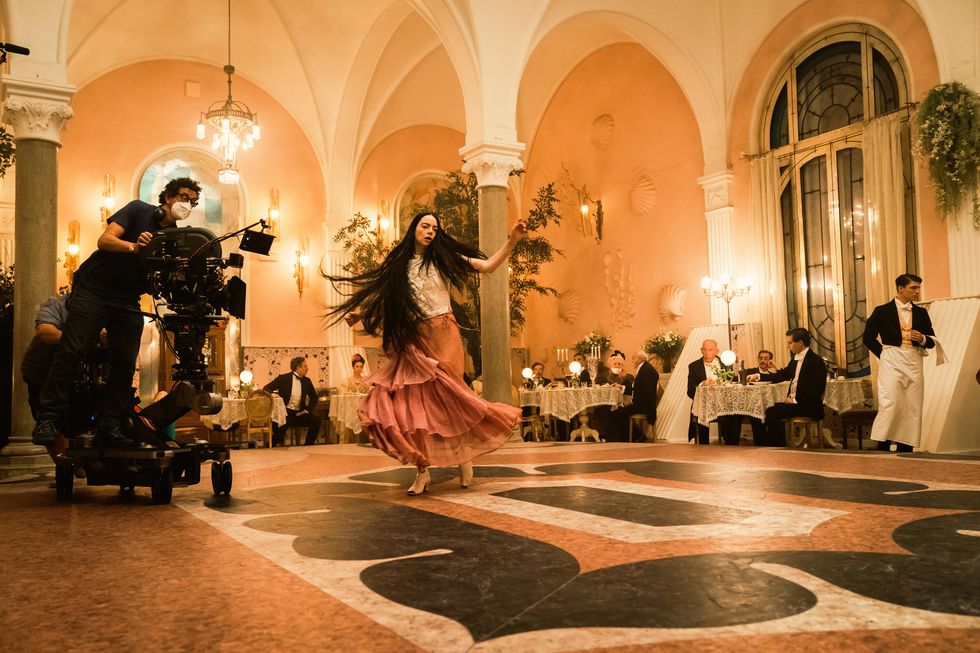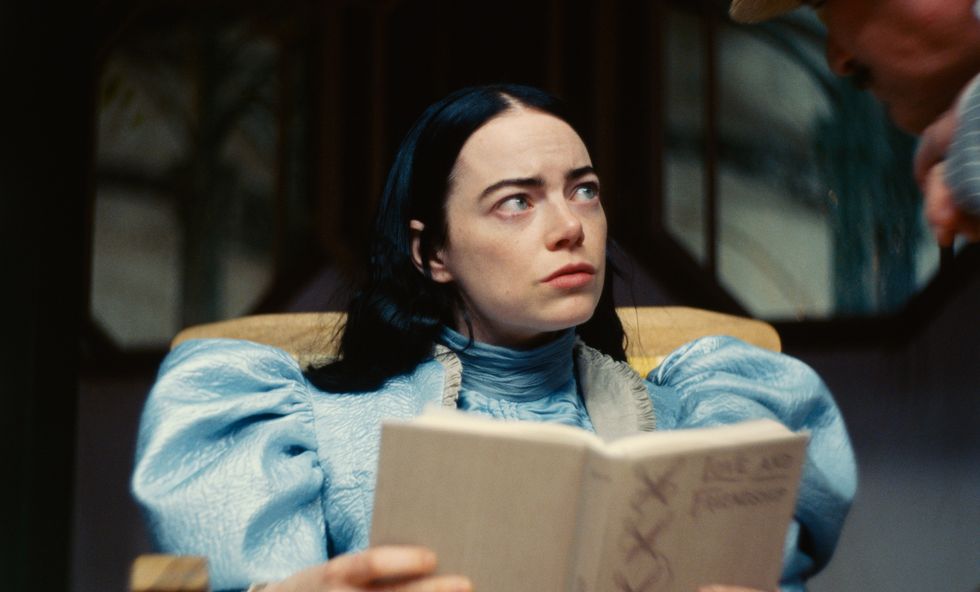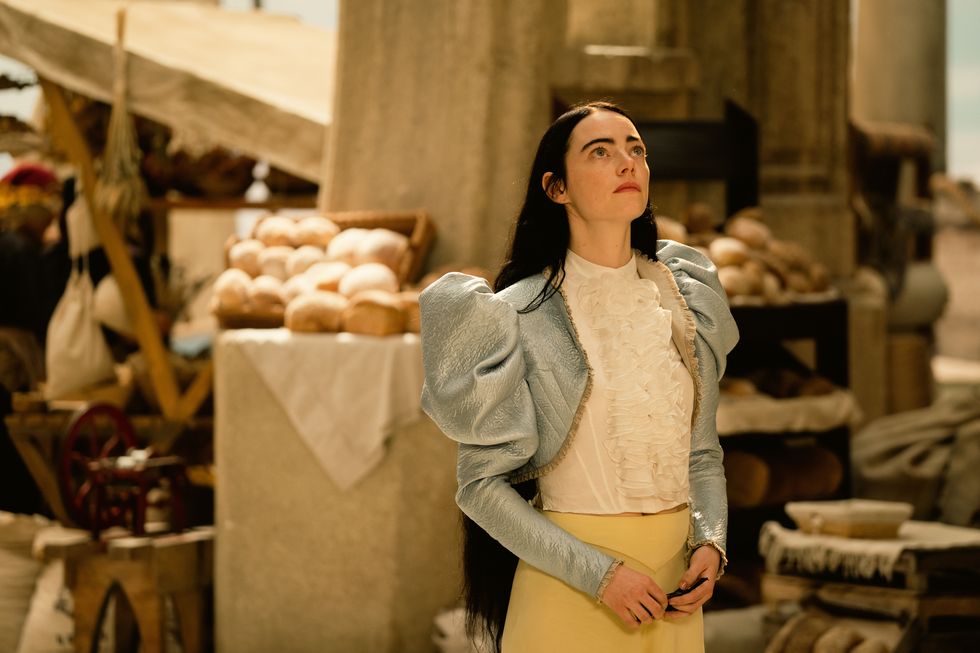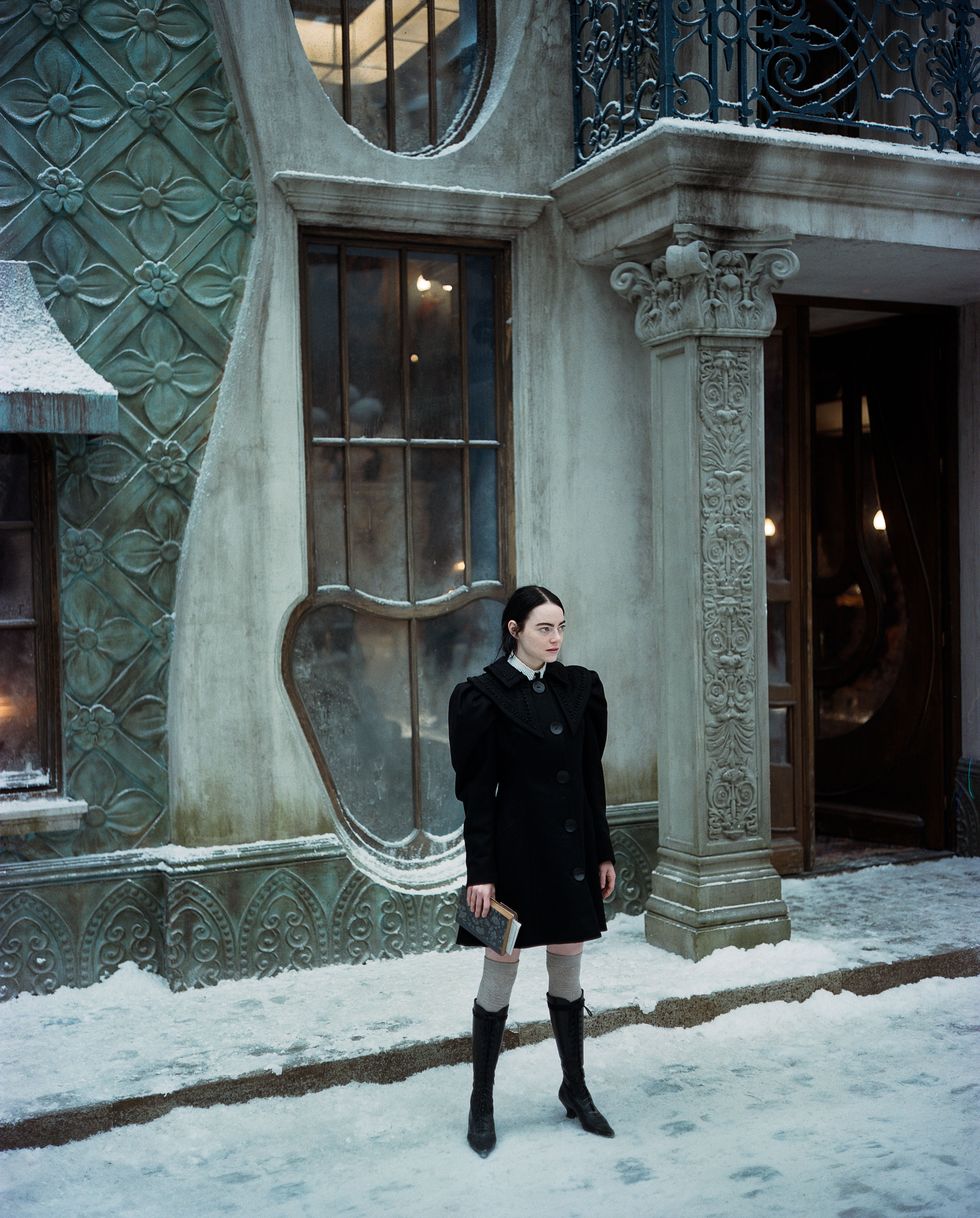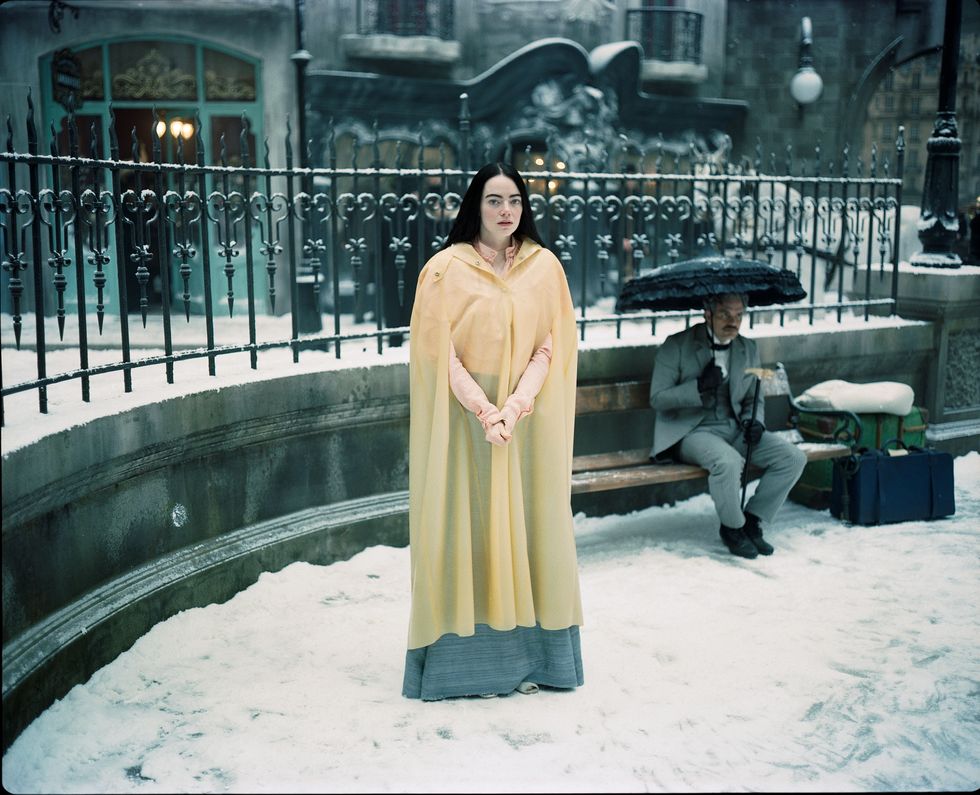‘Creature-Like’ Sleeves, a ‘Condom Cape,’ and No Corsets: How the Poor Things Wardrobe Came to Life
Minor spoilers below.
Our 2023 fashion bingo cards may not have expected a late entry for wanting to dress like a horny Frankenstein science experiment-turned-liberated woman, but Emma Stone’s Bella Baxter is a certifiable fashion plate. Stone commands the screen in her latest collaboration with Greek director Yorgos Lanthimos in Poor Things, where Bella is brought back to life by Dr. Godwin Baxter (Willem Dafoe). Initially stuck in childlike development in the body of a grown woman, she begins to outgrow her environment with her father-like keeper. When she runs off with a ridiculous lawyer, Duncan Wedderburn (Mark Ruffalo), Bella begins her journey to self-discovery through sexuality, education, and learning from those around her.
Bella’s growth, while shown through Stone’s tremendous performance, both physically and emotionally, also manifests through her clothing throughout the film. At first, she’s childlike in puffed sleeve nightgowns and bloomers, but once she leaves her whimsical homestead for unknown lands, the puffed sleeves are paired with frilled skirts and richer color palettes, all while still showcasing Bella’s unique sense of wonder about the world. The woman behind all those puffs and ruffles is costume designer Holly Waddington, who has worked on films like Lady Macbeth and the Hulu series The Great (created by Tony McNamara, who wrote Poor Things). Waddington, wearing a fabulous pair of earrings, talked to ELLE.com about working with Lanthimos and Stone on the film, how her own children inspired Bella, and the importance of texture.
How did you get involved with Poor Things?
I had worked with Tony McNamara on The Great. I designed the costumes for the pilot episodes and had a great time with Tony—we got on very well, loved working with him and loved his work. He made the introduction to Yorgos, so I got to have an interview with him, and it went from there.
Were you a fan of Yorgos’ work before?
Oh yeah. I have always loved his work, its subversiveness, its anarchic questioning of human behavior. As soon as I got a script emailed over, I was on a mission to get the job.
When you read the script, what were your initial thoughts in terms of thinking about the world and how you wanted the costuming to look?
It was quite a long journey actually. I’m trying to remember what the initial response was. The set designers, Shona Heath and James Price, already had done a huge amount of work when I came on board, and they produced this massive document, but I wasn’t party to that straight away. I think Yorgos wanted me to have my own process, which was a great thing. My big reaction was that texture felt like a very crucial aspect, and I needed to find a really good way of describing her arc and her journey. When she’s in the house in the beginning, I felt like I needed to crack that first. So that’s where I started.
When we first meet her in the house, she’s mismatched and girly. How did you want her to look when she’s sort of trapped and still working on her cognitive skills?
At the beginning, I was less concerned with what the final look would be. I was more concerned with what the conceit and logic would be, how it would evolve. So I probably spent most of my time trying to imagine, well, if she’s a young child, I would probably be asking Yorgos really specific questions, like, how old is her mental age? And he wasn’t really interested in giving me very specific answers.
In a way, that’s quite useful, because it encourages you to come up with it in your own way. In my mind, I had to create a structure for it all. She’s got this maid, who doesn’t really like her, to dress her, and Baxter adores her and has beautiful pieces of gorgeous clothing made for her that are very cosseting and often luxurious. The fabrics are very luxurious and a bit childlike but not too childlike, because she’s a grownup, and I didn’t want to put her in baby clothes. There would be something too obvious about that. So the logic that I was playing with was that she would be dressed by Mrs. Prim in the morning, and then very quickly into the day, she would’ve disintegrated. That was based on observing children myself. I have two little boys and have seen how often their clothes just come off. They like to be nude. They like to be free. And so I like this idea of a very elaborate top half with a stripped back bottom half, which for me is the stuff of nightmares. I might dream about walking down the street fully dressed from the waist up and just wearing a pair of knickers. It’s a sort of slightly discordant arrangement of clothes, isn’t it?
And what about when she leaves Baxter and her home?
She would no longer have Mrs. Prim, and she would have to put it together herself, and there would be moments when she would be helped by Duncan. He’s not going to go for dinner with her where everyone’s in evening wear and she’s wearing a mashup. So he would help her into a dress. Maybe he would buy her a dress, but then we would see her in other scenes where she’s kind of just stepped out into the street in her pants with half the costume on, or she would go out dancing, wearing a petticoat with the blouse worn the wrong way. I wanted her to feel almost like a five-year-old who’s dressing up in their mother’s clothes.
That sort of answers my question about the tap shorts. I loved all the tap shorts. I felt like, I saw Emma Stone wearing tap shorts in Poor Things, and now I want to wear tap shorts.
I love that you call ’em tap shorts. They are just joyful, joyful things. And I’m a big lover of Busby Berkeley musicals and things like marching girls. I did meet Emma Stone in Athens too, because we were preparing during the pandemic. I’m in London and most of the cast is in America. I couldn’t easily see them. Most of them were coming out two weeks before the shoot, and I knew that that wouldn’t really work for her character, because there was lots to think about.
So I had this fitting with her in Athens. I took a load of stuff out in suitcases and met her there. And we spent an afternoon trying to work out what we would do. And I did have lots of different, more Victorian-looking pants. They’re called bloomers. She does wear them a bit, but it felt like she needed to be a little bit more sophisticated. When she got to Lisbon, we did the wardrobe to shunt along a bit and to be less childlike and more playful. They’re basically ’30s French knickers. They just look great on her.
There’s so much texture to the clothing, like you mentioned. I love the puff sleeves and ruffles. None of it feels childish, but it also matures as Bella does. What was your inspiration for that?
The big sleeves came from Yorgos. He left me to get on with my own thing for a while, and then when we came back to look at everything that I’d come up with, he was very clear that he wanted these sleeves. On the first day of filming, that very textured thing that she wears at the piano, the sleeve was so big that it was impacting on how they could shoot her. That might be why people don’t do the 1890s in this way as a regular thing. When you go to costume houses, the sleeves were much smaller, but we decided to really dial them up, and go for them. I think what works is that they amplify well. They create this sense of empowerment. And they also affect her body shape and create this sense of otherness. They’re very creature-like.
I had a lot of references of really beautiful, almost anatomical drawings of shells and late Victorian studies of specimens. The frills of a sea creature, the dimples on a sea urchin, the textures in the body, the lining of the intestine, even cellulite. We had a couple of fabric buyers going around trying to find fabrics that had these textures, and when we couldn’t find them, we would make them. So we had this little smocking machine that would smock fabric to create these ripply, delicate [fabrics]. We did a lot of experiments on Poor Things. We did so many things that didn’t make it into the film, but we spent a lot of time creating textures.
It’s set in the Victorian era, and the costumes obviously show that, but it also feels so modern.
I think what makes it feel so super modern is partly that there is no corset. The corset gives it a very particular shape. That’s where the shape of the clothes comes from and gives a particular kind of gate and deportment and posture to the wearer. So by getting rid of that, there’s a sort of modernity there. Also, her hair being down, you don’t see that in period films, because people didn’t want their hair down like that. I also think the colors are very fresh. There’s a lot of strong, bold colors, and there’s a sort of modernity to a lot of the fabrics that we were working with. We didn’t have any lace, beading, feathers, or the things that you associate with Victorian dress.
I’d love to hear a bit about the color palette. Obviously it’s really bold, and then as Bella goes throughout the film, it gets darker during her socialist time in Paris and then tones down toward the end of the film.
She’s really focused by the end. She’s going to be a doctor. She’s fully evolved mentally, and she’s no longer dressing up. She’s about work now. So the clothes are really just clothes. It’s a jumper and a pair of culottes. It’s good for the period and the world, but it’s a sort of inconspicuous, understated look. I was thinking about beatniks actually with the black. I was thinking about socialist meetings, and her and her friend would be a couple of beatnik girls from the 1950s with their black clothes and berets and black boots but sort of transposed into a late Victorian world. I also wanted her to be very consistent with the men, because you look at these pictures of Victorian medical school, the men have all got these black frocks. Well, they look black, because it’s all pictures in black and white, probably. So they’re all wearing these black frock coats, and I wanted her to blend in with them in that scene in the medical school, but to be this moment of subversion when she gets up, and she’s not wearing a skirt or a dress, it just has her bare legs. I thought that was quite funny.
The brothel looks are so interesting, too. I love the bondage bra that she wears a couple times when she’s working there, because it feels like a mishmash of all of her other looks but sexy.
I was thinking that, by the time they got to the brothels, they would all have a house costume. They’d have a house coat that they would be presented with when they arrived to work there. Each woman in the brothel has a kind of body-revealing dressing gown. We did some of them full-length and some of them just to the waist and some of them were very exposed. They’ve almost got nothing on underneath, and some wore them with knickers and bits of other things. First of all, there were no corsets; that is unusual for a Victorian brothel, because the corset is a massively fetishized garment and still is. We decided to not do that and to let the bodies all just be as they were and to celebrate the breasts. So that for me felt like an interesting thing to do, to have the breasts exposed and also to work with a color palette that was taken from the body. Rather than using black and red or colors that we normally associate with pornography or sex work, I wanted to work with a very beautiful, delicate human palette.
I love the yellow raincoat so much. I want it so badly.
That’s the condom cape.
Poor Things is now playing in theaters.
Kerensa Cadenas is a freelance writer and editor based in New York. She’s previously worked at Thrillist, The Cut, Entertainment Weekly, and Complex. Her writing has been in GQ, Vanity Fair, Vulture, Cosmopolitan, and others.


